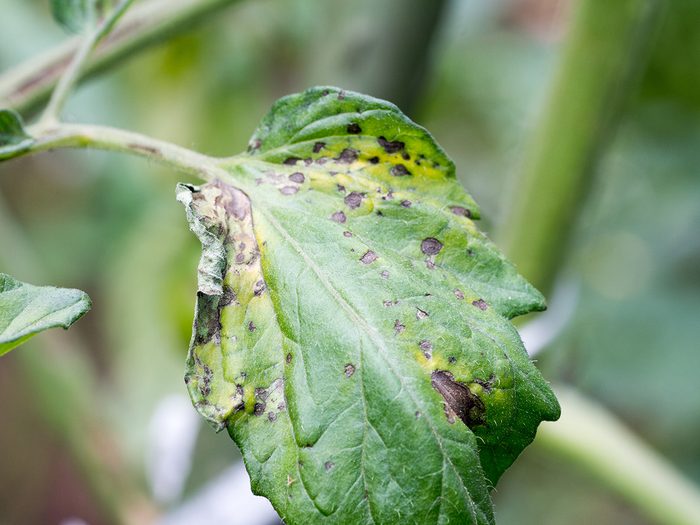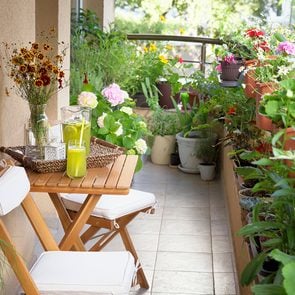If You See Purple Dots on Your Tomato Leaves, This Is What It Means

Purple leaves on your tomatoes could be a sign something isn't right. Luckily, there are ways to purge the purple and guarantee a healthy harvest.
Our editors and experts handpick every product we feature. We may earn a commission from your purchases.
There’s nothing better than sun-kissed, fresh-off-the-vine tomatoes, especially in the summer. Add a little basil, mozzarella and olive oil, and yum! Even better, these perennially popular home-garden crops are easy to grow (even as indoor plants), they don’t need much space and they produce tons of fruit all season long. However, without the right care, things can go awry, and you can end up with brown tips on your leaves or powdery mildew on your plants. But what if you spot purple leaves on the tomatoes in your garden? Is this a harmless anomaly or a sign that your plants are sick?
Let’s put it this way: It’s usually not something you should ignore. “Purple leaves on a tomato plant, while visually intriguing, can actually be a sign of distress,” says professional horticulturalist Amber Noyes.
Thankfully, this early warning sign can help you take steps to prevent your tomato crop from being obliterated. If you follow these expert-approved gardening tips, you’ll know exactly how to save your tomato plants.
Sign up for our Daily Digest newsletter for more home hacks, streaming guides and humour, all week long!
Why are there purple dots on my tomato plant?
A nutrient deficiency is the most common culprit, but it isn’t the only reason your tomato plant’s leaves or stem may start sporting spots or turning purple. That said, it’s essential to diagnose your plant’s specific problem if you want your plant to start producing those gorgeous tomatoes you’ve been banking on.
Phosphorous deficiency
A phosphorus deficiency is the leading cause of purple leaves on tomatoes, according to Noyes. This nutrient is essential for photosynthesis, the process by which a plant uses sunlight, water and carbon dioxide to create food for itself (as well as give off oxygen). How can you tell if this is your plant’s issue? It’s most common in new seedlings and transplants, and you’ll typically see the purple pop up on the stems and the undersides of foliage. You also might also see slow growth, necrosis of plant tissue and curling leaves. But it’s possible to revive a seemingly dead plant with this problem.
How to fix it: Use a high-phosphorus fertilizer on the soil. “The amount you’ll need will largely depend on the results of a soil test, but typically, a balance of 10–20–10 or 15–30–15 (N–P–K) is suitable for most tomato plants,” Noyes says. “The figures represent the ratio of nitrogen, phosphorus and potassium, respectively.”
To get the most accurate information on the nutrient levels in your yard, including phosphorus, purchase a soil-testing kit and send a sample to a lab for analysis. Instant-result testing kits are also available, but they aren’t as accurate.
Amateur gardeners can simply use a phosphorus-rich fertilizer according to the package instructions, typically every one to two weeks, until they notice an improvement in the plant’s health. “Once the purple dots disappear,” says Noyes, “continue to fertilize as directed by the product, but at a lower frequency, to maintain optimal plant health.”
Potassium deficiency
Potassium deficiencies also impact photosynthesis. They typically turn tomato-leaf edges brown and the veins yellow, though in some cases, purple spotting can also occur. This spotting is usually limited to the underside of the foliage.
How to fix it: As with phosphorus deficiencies, if a test shows your soil lacks sufficient potassium, you can apply a fertilizer high in this nutrient weekly until the purple colouring fades. Potassium levels are indicated by the “K” on the N–P–K numbers displayed on the label of all home-garden fertilizers. If you opt for a tomato-plant-specific formula, the potassium level will likely already be higher than it is for a normal fertilizer, so this is the way to go. Giving banana water to your tomato plant may also help, and it’s an easy and affordable option.
Magnesium deficiency
Less commonly, purple leaves on tomato plants can result from a magnesium shortage. “Magnesium deficiency often manifests as interveinal chlorosis, with the leaves turning yellow while the veins stay green,” Noyes says. “If the deficiency is severe, the yellowed areas can take on a purplish hue due to the accumulation of anthocyanin pigments.” Because you see the yellow discolouration first, if you’re proactive, your leaves shouldn’t reach the purple stage.
How to fix it: A natural way to increase the magnesium levels in your soil is to add Epsom salts. Dilute 1 tablespoon per U.S. gallon (3.75 litres) of water, and use this to water the plant soil every couple of weeks. However, do this only if a soil test clearly indicates a magnesium deficiency. Too much magnesium can hurt your plants by inhibiting calcium uptake. And to avoid leaf scorch, never spray the solution directly onto the leaves.
Cold soil
Sometimes your soil can have ample amounts of phosphorus, potassium and magnesium, but you still see purple leaves on your tomato plants and other symptoms consistent with a nutrition deficiency. In these instances, cold soil might be causing your problems. According to Noyes, cold soil inhibits the uptake of phosphorus and other nutrients.
Tomatoes are heat lovers, and a soil temperature of 65 to 75 degrees is ideal. When the soil drops to below 50, you’ll likely see stunted growth, and alongside discolouration, the foliage can wilt and experience surface pitting or lesions. Flowers begin to drop, and if your plant produces any tomatoes, they are unlikely to be the most flavorful.
How to fix it: “One way to combat this is through soil solarization, a method where you cover your soil with clear plastic and allow the sun to heat it over several weeks,” Noyes says. Alternatively, “adding compost or organic matter can also naturally raise the soil temperature.” Or you can try adding plastic or fabric mulch to trap heat in the soil, a method that kills weeds too. Regularly test temperatures using a soil thermometer; you can remove coverings once the ground is warm enough.
Too much sun
Tomatoes are fruits that love the sun, and they appreciate at least six hours of bright light daily. However, long days of intense sunlight during scorching weather can result in tomato sun-scald. The tomatoes crack and turn white or blotchy yellow, and the foliage tips can brown and curl. Sometimes the leaves turn red or purple. Purple leaves are especially common in delicate young seedlings.
How to fix it: Use a shade cloth to gently cover the plants if temperatures rise above 85 degrees F (29 degrees C). Or move the plants to an area where they still receive ample sun but not so much in the intense heat of the afternoon.
Genetics
Sometimes, purple leaves on tomatoes aren’t anything to worry about. “Genetics can play a role in the colouration of tomato plants, with some varieties naturally producing a more purple hue on their leaves, such as the Indigo Rose or Black Krim,” Noyes says. In that case, there’s nothing to fix because there’s nothing wrong!
Tomato spotted wilt virus
Tomato spotted wilt virus is an increasing problem in North America. The disease starts with dark brown or purple spots or veins on the foliage. Later, these spread to the stems and form necrotic cankers, which eat away at your plant until it dies.
This disease is transmitted by pests—specifically, at least nine different thrip species. These tiny winged insects, also known as thunderflies, don’t just transmit this virus; their feeding habits also directly damage fruit, foliage and shoots, giving plants an untidy appearance.
How to fix it: Unfortunately, this disease is incurable. It’s best to remove infected plants immediately to prevent spread.
Find out how to get rid of fungus gnats.
How long will it take for these treatments to work?
The purple leaves on your tomato plants may or may not green up with appropriate nutrients, warm soil and the right amounts of sun over a few weeks. The timing depends on the extent of the damage, the plant’s overall health and the general growing conditions. Also, keep in mind that while new leaves should be a healthy green, seedlings subjected to cold soils or poor nutrient levels for prolonged periods of time could remain stunted and produce inferior fruit.
Of course, if you aren’t seeing any changes after a few weeks of treatment or the situation is getting worse, your plant could be beyond saving. Sometimes, it’s better to cut your losses and start germinating a fresh, healthy batch of tomato plants, making sure to offer the right conditions from the beginning.
How to prevent tomato leaves from turning purple
As the saying goes, an ounce of prevention is worth a pound of cure, and that’s very true when it comes to purple leaves on tomatoes. To avoid unsightly spots and unhealthy crops, Noyes recommends being proactive with the following gardening tips:
- Regularly test your soil to ensure the nutrient levels are right.
- Pick a site where the soil won’t be too cold and the sun levels are appropriate.
- Monitor plants for disease-spreading thrips, and if you spot them, use insecticidal soap to remove them promptly. How can you identify them? Thrips are yellow, brown or black elongated winged insects around one-eighth of an inch (3 millimetres) long. Telltale signs that you have the start of an infestation include dried brownish-black poop spots on the underside of foliage and scarring on the leaves. If you tap the plant’s leaves while holding a piece of white paper under it, thrips may fall onto it.
What else should you keep in mind about growing tomatoes?
Of course, knowing how to prevent and treat purple leaves on tomatoes isn’t the only thing you need in your gardening repertoire. Here are a few other tips for nurturing happy and healthy tomato plants.
- Know your planting calendar, and grow tomatoes outdoors only after the danger of late-spring frosts has passed in your region. Alternatively, grow them in a protected greenhouse.
- Plant in loamy, well-drained soil.
- Pick a site that offers six to eight hours of sunlight.
- After testing the soil to establish the right formula, offer regular fertilizer to these heavy feeders.
- Select cultivars (human-developed plant-species varietals) best suited to your climate.
- Thin out seedlings when they are around two to three weeks old so the remaining plants have ample airflow and room to spread. Ideally, there should be 1-2 feet of space between individual mature plants.
- Water plants deeply and regularly to provide consistent moisture, easing up once fruit appears.
- Plant deeply, and stake tall plants for extra support.
- Don’t plant in beds that have had other nightshade family members, such as potatoes or peppers, in them over the last couple of years. Plant rotation using different crop families helps produce better harvests by disrupting pest and disease life cycles and improving soil nutrients and fertility.
About the expert
- Amber Noyes is a horticulturist and the editor of Gardening Chores. She has a master’s degree in horticulture from the University of California and a BS in Biology from the University of San Francisco.
Sources:
- University of Maryland Extension: “Key to common problems of tomatoes”
- Clemson Cooperative Extension: “Tomato diseases & disorders”
Check out more expert advice on starting a garden.






